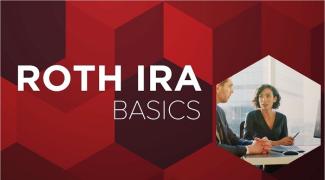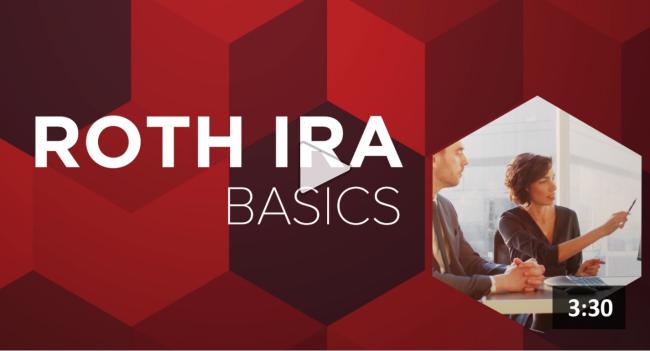
[Video] Understanding the Basics of Roth IRAs
Roth IRAs are common retirement savings vehicles because they allow investors to build a source of tax-free retirement income.
Understanding how a Roth IRA differs from a traditional IRA can help you determine if it might be appropriate for your needs.
Click the image below to watch a quick video, or read more below.
The Traditional IRA Versus the Roth IRA
With a traditional IRA, you can get an immediate tax benefit if you’re eligible to deduct your contributions. Note, however, that you will owe taxes on any deductible contributions and earnings later on, when you withdraw the money.
With a Roth IRA, there’s no immediate tax benefit – you can’t deduct your contributions. Instead, the tax benefit comes later, when qualified withdrawals will be tax free at the federal – and possibly state – level.
In effect, you’re trading a potential tax benefit now for a tax benefit later.
You can make a qualified withdrawal from a Roth IRA if you have held it for at least five years, and you either reach age 59½ or another qualifying event applies.
3 Ways to Fund a Roth IRA
1.) You can make annual contributions to a Roth IRA, provided you have earned income and your modified adjusted gross income does not exceed certain limits.
2.) You can convert a traditional IRA to a Roth IRA.
3.) You can convert a retirement plan account to a Roth IRA.
If you choose the second or third option – converting assets to a Roth IRA – the amount you convert generally will be included in your income for the year of the conversion, except for any non-deductible contributions you've made. That means you’ll have to pay regular income taxes on any deductible contributions and earnings.
For example, if you convert a traditional IRA that’s worth $250,000, including $100,000 of non-deductible contributions, you’ll need to include $150,000 in your income for the tax year of the conversion.
When to Consider a Roth Conversion
You might consider a Roth conversion if you expect to be in a higher tax bracket in retirement.
It may also be appealing if you earn too much to make regular contributions to a Roth. In this case, you could first contribute to a traditional IRA and then convert it to a Roth IRA.
Is a Roth IRA Right for You?
The answer depends on many factors, including your income tax rate both now and in the future, when and if you'll need to take withdrawals from the Roth IRA, your state's tax laws, and whether you plan to make regular contributions or convert assets.
Be sure to fully understand your options and the potential tax consequences before making any decisions.
Want to discuss your options and see whether a Roth conversion might make sense for you? Request a free initial strategy session with one of our Certified Financial Fiduciaries® today.
Disclosure:
Contributions to a traditional IRA are tax deductible (subject to certain income limits), and any earnings in the account are not subject to income tax until withdrawn. IRA withdrawals (also called distributions) are subject to ordinary income tax. Distributions taken prior to age 59½ may be subject to an additional 10% penalty, with certain exceptions such as the owner’s death, disability, or a first-time home purchase ($10,000 lifetime maximum).
To qualify for the tax-free and penalty-free withdrawal of earnings, a Roth IRA must meet the five-year holding requirement and the distribution must take place after age 59½ or due to the owner’s death, disability, or a first-time home purchase (up to a $10,000 lifetime maximum). Nonqualified distributions from a Roth IRA are subject to regular income taxes and, if taken prior to age 59½, a 10% penalty.
Penalty-free (but not income tax-free) distributions may be allowed from both traditional and Roth IRAs in certain circumstances. See IRS Publication 590-B for more information.
Video prepared by Broadridge Advisor Solutions, Inc. & used with permission. Copyright 2023.

